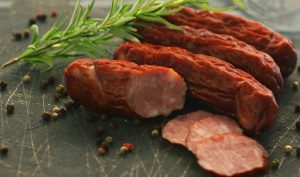As we know, a raclette is nothing without a quality cheese. But the same could be said for charcuterie. Ham, sausage or even dried meat from the Alps, there is something for everyone. Presentation.
Charcuterie, a tradition in Haute-Savoie
The Haute-Savoie charcuterie can be considered as a tradition and its preservation method has existed for a long time. But for many years, these cured meats were primarily consumed on a local basis. It was not until the emergence of gastronomic tourism in the 20th century that Savoyard charcuterie was exported throughout France.
Savoy cured ham

Extra info: juniper and fir wood are the most commonly used for smoking.
Dry sausage

It must be said that the pig has always had a significant place in the farms of Savoie and Haute-Savoie. In 1866, more than 70,000 pigs were counted in the two departments.
Extra info: given the mountain climate, drying quickly became the preferred method of preserving sausages.
The diots of Savoie

Our tip: to add flavour to your diots, don’t hesitate to add a little thyme.
Local specialities
Other specialities, sometimes less well known, are nevertheless worth a visit. We suggest you discover some of them.
The smoked sausage of Magland

Our tip: Magland smoked sausage can be served as a dish. Simmer it for a few minutes in boiling water and serve it with steamed potatoes.
Pormonier

Extra info: Pormonier is made of pieces of meat that cannot be dried and vegetables such as spinach and leeks.
Specialities of our Swiss neighbours
Charcuterie is part of the local heritage of the mountain people. And this is not limited to France. In Switzerland, too, certain salted meats are highly appreciated. We suggest you discover two of them.
Meat from the Grisons
Bündnerfleisch is also called Alpine dried meat. It is a speciality from Switzerland and more particularly from the canton of Grisons. The taste is due to the fact that it is prepared with spices and herbs from the Alps. It is traditionally eaten in winter.
Extra info: Bündnerfleisch is appreciated for its low caloric value.
Longeole

According to legend, this sausage was created by a monk from the abbey of Pomier. Variations exist in Haute-Savoie, in the Chablais and lower Arve Valley areas.
Our tip: cook the longeole for 3 hours in water over a low heat.

















